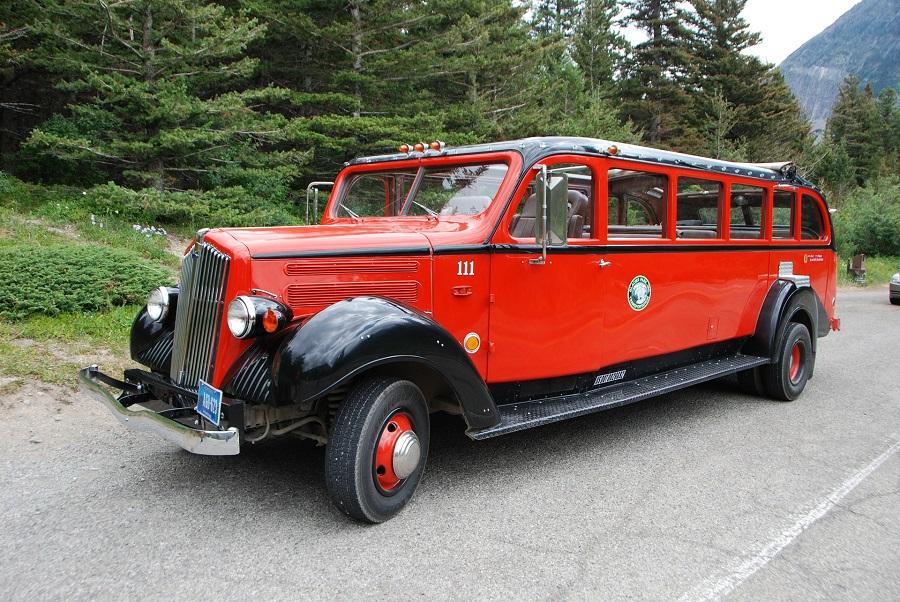
Glacier National Park's famed Red Buses will get overhauled this year/Pixabay
For those visiting Glacier National Park, the iconic red buses remain a trip favorite. Black and crimson, shiny, and comfortable, the buses transport their riders back in time. However, even they need some modern upkeep, and park staff begin an extensive rehabilitation project this year.
The White Motor Company Model 706 buses were manufactured between 1936 and 1939, painted the color of ripe mountain ash berries, and originally purchased by the Glacier Park Transportation Company. The Ford Motor Company donated time and money for the previous red bus rehabilitation, which occurred in 1999.
The rehabilitation will replace the current Ford engines with a Ford 6.2L V8 engine assisted by an electric hybrid system to reduce fuel consumption and emissions. The electric hybrid system will be powered by a battery bank that will charge when the vehicle decelerates including on downhill runs, which are frequent in the park. The buses will be remounted on new Ford chassis retaining the existing 176’ wheelbase, as they were with a previous restoration. Tire size will be expanded from 16’’ to 19.5’’ to approach historical dimensions. The dashboard and gauges will be replaced with historic replicas, and the buses will undergo refinishing, including rust removal and painting using the historic mountain ash color.
President Taft designated Glacier National Park in 1910, making Glacier the 10th unit in the national park system. The red buses have been a signature fixture in the visitor experience for the vast majority of the park’s history. The improvements will ensure that the fleet continues to operate in Glacier National Park for the foreseeable future, with improved safety and serviceability, while retaining the same visitor experience in the park that has existed for over 80 years.
The National Park Service included the rehabilitation as a responsibility in the most recent concession contract that Xanterra Travel Collection was awarded in 2014. Xanterra Travel Collection has selected Legacy Classic Trucks, based in Driggs, Idaho, to do the rehabilitation. Once complete, visitors will once again be able to choose tours that last 2.5-9.5 hours, taking in the beautiful sights and sounds of Glacier National Park.
One recent rider – Steve – says it all in his review on Trip Advisor: “My wife and I recently visited Glacier NP. We took the Red Bus Tour and it was the highlight of our visit. The old restored White Truck Red Buses held 17 guests and had an open top which is open if the weather is agreeable. Thankfully it was while we were there. Our tour guide GLEN was extremely [knowledgeable] about the park, the history, plants, animals, etc. We can't thank him enough for the wonderful experience. Anyone visiting GNP should take this tour. It is worth every penny.”





Comments
I don't know if there's any easy way around over a century of no questions fire supression in an environment that had millenia of natural fire taking care of the ecosystem. I'm OK with controlled burns as mitigation. They're doing what they can with the personnel and budget that they have.
But it's pretty clear that Trump blurts out stuff without asking for any input from anyone who actually knows what they're talking about. For him there's always someone else to blame - especially if it can be said in a partisan manner. You don't remember when he was blaming water policy for the severity of the fires in California? As if putting out fires with water is primarily how wildfires are fought, and ignoring that firefighting aircraft were dipping into reservoirs with no issues.
His claims are no less accurate than Brown's blaming it on climate change.
That's just ignorant. While you may or may not agree with the assessment that dry conditions and high winds are a result of human-created climate change, there's no question that the spread of the fires was extremely fast as a result of those conditions.
Trump's claims are demonstrably inaccurate. As in not subject to opinion. There's no equivalence in claiming that water policy resulted in lack of water to utilize to fight fires.
But there is no evidence that those conditions were caused by climate change. If the trend in fires is being driven by climate change then the climate is cooling. The early 1900s had far more fires and far more servere fires (measured in acres burned) than we see today despite the fact the existence of the largest cause of fires -man- has nearly tripled in that time frame.
calm down